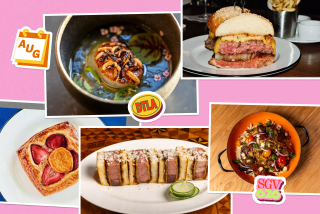Look closely for whimsical architecture
“If . . . you found you could buy cakes in a windmill, ices in a gigantic cream can, and flowers in a huge pot, you might begin to wonder whether you had not stepped through a looking glass or taken a toss down a rabbit burrow and could expect Mad Hatter or White Queen to appear . . . “
John Crossland, “Modern Marvels Encyclopedia” (1938)
--
But, no, you had only stepped into L.A.
Part of Southern California’s reputation for goofiness dates back to these pre-World War II buildings, which were often shaped liked the things they sold:
The Tamale restaurant on Whittier Boulevard, a giant Mexican dish with its corn husks tied at both ends; the various Chili Bowl eateries with their circular dining rooms; the Darkroom photo shop on Wilshire Boulevard with an entrance resembling a camera, complete with lens and shutter-speed indicator.
“This was a response to the automobile and the cultural mores of the ‘20s where people cut loose,” said historian Jim Heimann, author of “California Crazy & Beyond: Roadside Vernacular Architecture” and several other books.
“You wanted to catch the eye of people in automobiles. And there was so much open space -- it wasn’t like Chicago or New York.”
The demise of the trend began after World War II when Southern California became more densely populated, real estate prices rose and chain businesses appeared.
Many of the buildings -- especially those in pricey areas -- have been bulldozed. Now, you need a sharp eye to spot artifacts. Heimann has that sharp eye.
He was driving down Pico Boulevard once when he found the long-missing, albeit reincarnated, pickle that used to adorn the roof of Pickle Bill’s restaurant in West L.A.
“I spotted this Tiki god with bumps near the entrance to Kelbo’s Barbecue,” he said, “and I thought, ‘No, that can’t be the pickle!’ But I checked and it was.”
A strip club now occupies the location and the pickle has disappeared.
Another time, driving through Alhambra, “I noticed a pointed thing with a waffle-cone structure peeking out from the back of a building,” Heimann recalled. “My mind said, ‘Uh, oh, I think I see a cone.’ ”
Sure enough, it was a former Big Cone.
Also hidden is what’s left of the once-world-famous Original Brown Derby restaurant on Wilshire Boulevard -- it now forms part of a Korean restaurant inside a nearby shopping mall.
Some survivors of the daffy architecture era might prompt double-takes today.
The Tamale’s home has not unraveled, but inside the 80-year-old husks you’ll find Charley’s Beauty Salon.
One old Chili Bowl in West L.A. houses Mr. Cecil’s California Ribs, which did not, however, retain the Chili Bowl motto: “We cook our beans backwards -- you only get the hiccups.”
And the Darkroom, a historical landmark whose camera facade remains intact, has become El Toro Cantina. Owner Paul Boettcher says customers don’t ask about the facade -- folks in L.A. are evidently blase about cameras.
The former Big Donut shops have changed with the times too. One in Long Beach calls itself the Daily Grind Espresso Bar. Another, a few miles north, covers its giant chocolate doughnut with the shocking words, “Bellflower Bagels.” But Randy’s Donuts off the 405 Freeway near Inglewood still proudly emphasizes doughnuts. And no espresso.
Some of the roadside wonders have become anachronisms.
What’s that sculpture atop Capitol Records on Sunset Boulevard? A stack of 45 rpm records? Where do you load the CDs?
The old Samson tire factory off the 5 Freeway, whose front wall depicts scenes from the reign of an Assyrian king, is now a shopping center called the Citadel. Its walls carry ads for 21st century clothes, alongside the carvings of Assyrian holy men wearing 8th century BC duds.
In Culver City, the Allied Models train shop occupied a building shaped like L.A.’s Union Station terminal until a few years ago, when it moved into a smaller, nondescript home.
“It has become increasingly more difficult to run a single store like mine in a major metropolitan area,” said Allied’s Allen Drucker
Now the mock train depot is occupied by Samy’s Camera shop.(Too bad the Darkroom was already taken).
But at least these buildings have avoided the wrecking ball.
Not so lucky were such sights as Sanderson’s Hosiery, with a 30-foot-tall right leg on the roof; the mountain-shaped Mount Baldy Inn, later subdivided into a dance club and an upholstery shop; and the Toed Inn, which invited customers to eat inside a toad.
Also in jeopardy is the Tail of the Pup, immortalized on the cover of the book “California Weird.” The stand’s 17-foot hot dog has been in storage since 2005, displaced by developers but still hoping to find an affordable hunk of land before it gets too soggy
A lack of business brought down the Burger That Ate L.A. eatery, which depicted a hungry sandwich taking a bite out of City Hall.
One trend-bucker is artist Claes Oldenburg’s 3-story-tall binoculars, which became the entrance to a Venice office building in 1991.
And a big comeback was made last year by the slightly less artistic Chicken Boy, a 22-foot-tall half-man/half-fowl mascot. Initially saved by designer Amy Inouye when its downtown fast-food home was leveled, Chicken Boy languished in storage for two decades -- its head in one unit, its torso in another. Finally, the city allowed her to install it atop her Highland Park studio as an “art installation.”
Inouye’s motto for Chicken Boy is “Too big to live, too weird to die.” It’s a shame the second part of that sentiment can’t be said for many of the area’s other historic oddball structures.
--
More to Read
Sign up for The Wild
We’ll help you find the best places to hike, bike and run, as well as the perfect silent spots for meditation and yoga.
You may occasionally receive promotional content from the Los Angeles Times.






